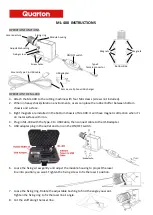
Measurement Technology NW
LCI-90 Operator Manual
Page 16
Isolated Input – 4-20 mA Isolated Process Current Loop with Module
TB6
Force Xducer: Current Output
MOD1 - V+
EXCI
TB6
MOD1 - S+
Note: 2 wire 4-20 process current loop module must be inserted in correct position.
Figure 4.9 – Tension Hookup – Isolated 2 Wire 4-20 mA Signal
Isolated Dual Axis Input – Two 4 Wire Strain Gauges with Modules
TB6
Force Xducer: Strain Gauge
MOD1 - V+
X-AXIS EXCI
MOD1 - V–
X-AXIS EXCITATION –
MOD1 - S+
X-AXIS
MOD1 - S–
X-AXIS SIGNAL –
MOD2 - V+
Y-AXIS EXCI
MOD2 - V–
Y-AXIS EXCITATION –
MOD2 - S+
Y-AXIS
MOD2 - S–
Y-AXIS SIGNAL –
Note: Each 4 wire strain gauge module must be inserted in correct position.
Figure 4.10 – Dual Axis Tension Hookup – Two 4 Wire Strain Gauge Inputs
4.1.3 Count Sensor Inputs
The count sensor inputs are terminated on TB4. The LCI-90 can accept NPN and
PNP type proximity and Hall-Effect inputs, as well as TTL/CMOS encoder inputs.
The input voltage thresholds are set to accommodate all these ranges with no adjust-
ment. These thresholds are 3.4 Volts for low-high transitions, and 2.3 volts for high-
low transitions.
Each different sensor type requires a specific DIP switch setting (see Appendix B).
Below are the wiring diagrams for the different sensor types with typical excitation
voltages.
















































